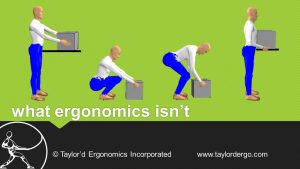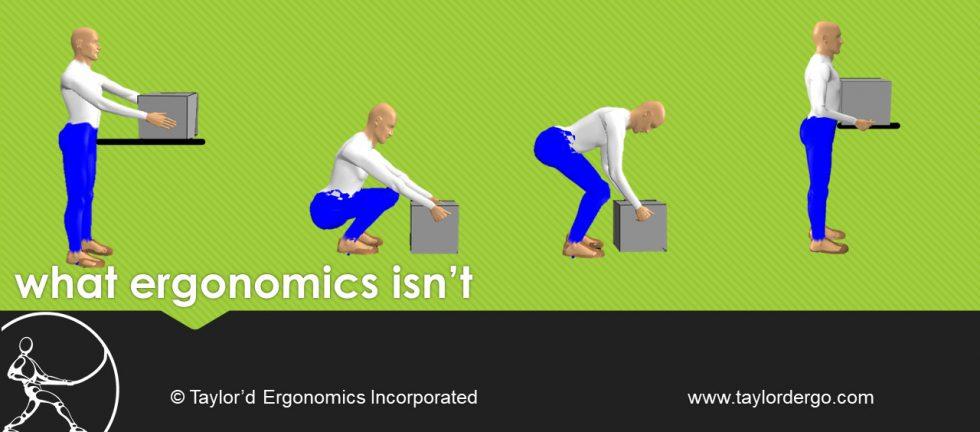Some people think that ergonomics is about teaching people to sit up straight and lift with their legs. When we do an assessment, unless we explain very carefully that we’re hoping to see people working the way they normally do, we’re sometimes entertained by a “show” of what people think we want to see. When we’re collecting data, some people keep their backs ramrod straight and lift with very unnatural movement patterns. They move in very slow, controlled ways, never using momentum. In offices, they sit up straight, even if their feet are dangling above the floor. If we ask why they are doing these things, they’ll sometimes confess that they were trying to work “ergonomically”.
Although we’ve talked a lot in this blog about stretching, strengthening, best practices, and employee training, we all need to remember that ergonomics is much more than work methods! Exercise and coaching aim to fit the worker to the work – adapting the human to the work environment. Ergonomics really means fitting work to people. While there is value in teaching people how to use their bodies more efficiently, most “real” ergonomics is accomplished by making changes to the workplace, not the worker. For example:
- Instead of coaching a worker to keep the back straight, we should ensure that the work can be performed within a reasonable reach, so the worker doesn’t need to bend or reach forward. Reduce the depth of work tables, use diverters to push items closer, or re-orient items so it’s possible to grip them without reaching.
- Instead of focusing on bending the knees, we should position items around waist height, so the worker doesn’t need to bend down. Prioritize the middle shelves in storage areas for heavy and frequently-used items, use lift tables, or provide height-adjustable work benches.
- Instead of asking a worker to hold a tool with two hands or take frequent breaks, we should suspend the tool on a balancer, or choose lighter tools.
- In addition to advising office workers to adjust the chair so the hips and knees are bent at 90 degrees, we should ensure that their furniture will adjust to allow foot support in this position.
Research has shown that changing the workplace is more than twice as effective as training the worker. Goggins et al. (2008) showed that changing behaviour is about 10-20% effective, whereas reducing the level of exposure is 40-60% effective.
We train the worker when we cannot improve the workplace, or as an interim measure until we can change the workplace. After all, a 10-20% reduction in injuries is still worth pursuing! But if you’re looking for effective injury reduction, productivity improvement, or performance quality enhancements, take a closer look at the job, rather than the worker. Let’s design work for humans!
p.s. For those of you who are still trying to interpret the image above….the two mannequins on the left represent attempts to follow ergonomics training to “keep the back straight”.
- On the left, the worker lifts with back straight but arms outstretched. If the box is heavy, this worker may not have the arm strength required for the task.
- The second worker is keeping the back straight at the expense of arm strength and balance. If the box is heavy, his arms or knees might not be up to the task.
- The semi-squat lift, which is a compromise between bending the back and bending the legs, might be more practical for the box on the floor.
- The mannequin on the far right represents an ergonomic change that allows the worker to lift the box with the hands closer, at a good height, and with a stronger grip.



